 Picture shows a man’s head on the stool by the side of a kneeling person.
Picture shows a man’s head on the stool by the side of a kneeling person.
Human sacrifice was practised by various cultures at various levels. We have references to sacrifice of human beings in the Vedas and Tamil literature and sculptures. In fact there is no religious book which has not got a reference to it. There is no civilization where it was not practised. Historians only talk about Mayans nowadays. But it was practised on a large scale in the Middle East. We have unusually, disproportionately large number of children graves in Bahrain. It was practised in the early dynasties of Egypt. When the pharaoh died, lot of his servants, officials, queens were buried with him. They were administered with quick acting poison or a tranquilizing drug. They all did in an orderly manner. Bible and Jewish literature refers to it a number of places.
It is also known from Sumer, where the death pits of ur and kish contained rich burials of royal or sacred personages attended by dozens of retainers, guards and courtiers. Even during the death of Gilgamesh, his intimates were sacrificed around 2700 BC.
In some places, like Mayans, it was done ritually. Hindu Heroes sacrificed themselves to infuse heroism and patriotism before wars. They cut their heads by their own hands. We have sculptures depicting this scene. Hindu ladies threw themselves in husband’s pyre (called Sati) even when others stopped them. Sangam Tamil literature has a beautiful verse in Purananauru sung by the wife of Pandyan King. Bhutapandyan Devi simply ignored the requests of all the ministers and threw herself in the fire. But it was not compulsory. Even when the Pandava king Pandu died, his wife Kunti did not die by Sati. When Rama went in to the Sarayu River, thousands of his followers followed him into the river, says Ramayana. But we can see a clear dividing line between voluntary sacrifice and forced human sacrifice.
In Sri Lanka, Ravana’s sons Meghanada and Indrajit did human sacrifice in the cave of Nikhumbila according to Ramayana.
Picture shows Kalibhangan Spear Fight.
Same scene in Egypt and Indus
An ivory label from Djer’s reign has two figures facing each other. One seems to be plunging a knife into the other’s breast.;he holds ready a vessel, of a typically elegant first dynasty form, in which presumably, he will catch his victims blood. It seems certain that what is shown here is a rite of human sacrifice (page 121, Egypt’s Making by Michael Rice).
Indus valley has two or three human sacrifice scenes. On a seal we see two warriors piercing each other’s body in front of a god, similar to scenes in Egypt. A cylinder seal from Kalibhangan shows two soldiers spear each other. They have their hair tied into double bun
In another seal we have a man bowing before a goddess with a big animal. In the fig deity seal of Mohanjo- daro (M1186) a human head was placed on the altar beneath the fig tree. The hair on this head is bound at the back into a double bun. This suggests that the human head on the fig deity seal belonged to a warrior.
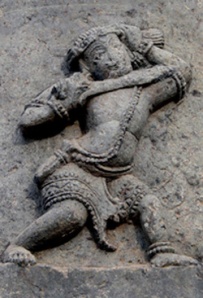
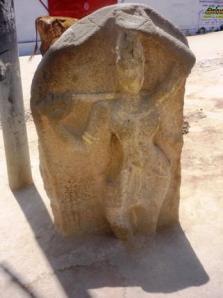
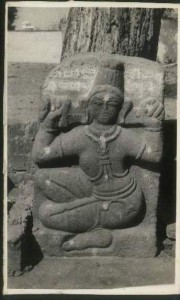

Pictures of Navakandam from Tamil Nadu and Karnataka
Human Sacrifice in Mahabharata
Another type of human sacrifice is offering one’s life for the success in a war. This is first seen in Mahabharata and then in Tamil literature. Rajasthani flk literature also has got such tales. This is a self motivated sacrifice. No one puts anyone to death. Aravan also known as Irawan, son of Arjuna and Naga princess Ulupi offers his head for the success of Pandavas. This tradition is well known in South East Asia and Northern parts of Tamil Nadu. A lot of temples have Aravan’s head. In Rajathan the same story is told about Khatusyamji, also known as Barbarika (Belar Sen). In Nepal, he is known as Yalamabar. So we can conclude sacrificing one’s head for the success in war is as old as Mahabharata.
Navakandam (Nine Cuts) In Tamil Nadu
Navakandam means Nine Cuts. A heroic soldier ritually cuts himself in nine places and dies in front of Goddess Durga also known as Kotravai just before a war. He does it for the welfare and success of the king and kingdom. This was a great patriotic act. The people who have sacrificed their lives for sake of the country are honoured by the Tamils. They install statues for them and do Puja. We have got beautiful sculptures depicting this heroic deed.
Jayamkondar, author of Kalingatuparani, wrote songs about this practice of Navakandam in 9th century AD. Oldest Tamil book Tolkappiam and Manimekalai, one of the five epics, also mention it. Maravars of Tamilnadu and Nayars of Kerala practised this ritual.
Pictures of Hand Prints by women who committed Sati in Jodhpur Rajasthan & a Navakandam
Following are the places where Navakandam happened:
Thanjavur—for the success of a Choza king
Mahabalipuram fifth ratha of Kali—
Madurai Madapuram mariammn temple—Siththira sarithan & Vallabhan
Thenkarai village— Near Sholavandan
Mallal, Ilaiyangkudi—Prayer to Kali for the welfare of the king
Sathipattu near Panrutti—for ruler Athirajamangalyapuram
We have statues of the heroes in Navakandam pose.
Kundrakudi temple wall- For Durga
Mannarkottai—for the welfare of his master.
Tirupparankundram—to save the temple from invading army jumped from the tower. Strictly speaking it was not Navakandam, but a sort of ritual sacrifice.
Human Sacrifice in Sikhism
Different types of suicides or sacrifices are known through historical documents. When the Sikh leader Guru Gobinda Simhan asked for five volunteers who can sacrifice their lives against foreign invaders, five people came forward. Though he did not kill them he pretended as if he had already sacrificed them by showing blood stained sword. All the five were declared as Sikh leaders. This shows that sacrifice for the country or religion existed in all parts of India. He asked them to come forward for sacrificed at the altar of Goddess. Tamil poet Bharathiyar has sung beautifylly about this under Guru Govindar.
Chittoor Rani Padmini entered fire with hundreds of her women colleagues to avoid molestation by foreign invaders.
Read my other posts on Indus and Egypt:
1.The Sugarcane Mystery: Indus Valley and the Ikshvaku Dynasty
2.Ghosts in Indus Seals and Indian Literature
3.Flags: Indus Valley- Egypt Similarity
4.Bull Fighting: Indus Valley to Spain via Tamil Nadu
5.Tiger Goddess of Indus Valley: Aryan or Dravidian?
6.Indra on Elephant Vahana in Indus Valley
7.Vishnu Seal in Indus Valley Civilization
8.Indus Script Deciphered
9.Tamil articles: சிந்து சமவெளியில் பேய் முத்திரை
10.சிந்து சமவெளியில் ஒரு புலிப் பெண்
11.கொடிகள்: சிந்து சமவெளி- எகிப்து இடையே அதிசய ஒற்றுமை
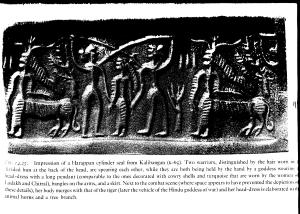
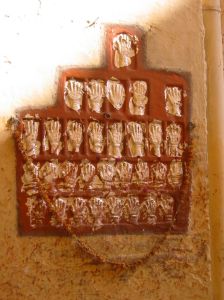


You must be logged in to post a comment.